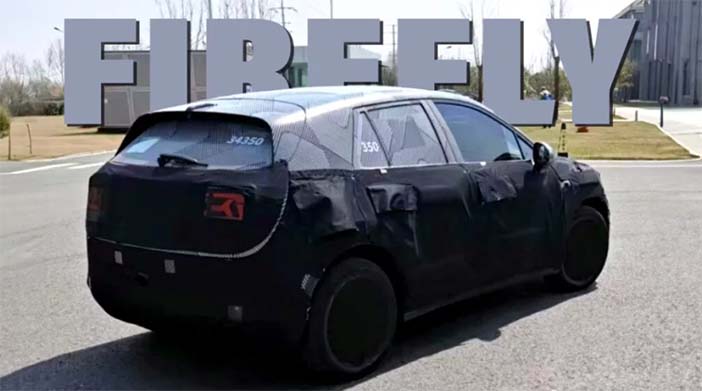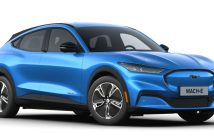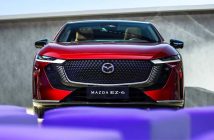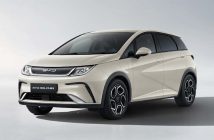+++ CHINAis building its military and nuclear arsenal on a scale not seen by any country since World War II and all signs suggest it’s sticking to ambitions to be ready to invade Taiwan by 2027, a top US admiral told Congress Wednesday. Beijing’s official defense budget has increased by 16% over recent years to more than $223 billion, said Admiral John Aquilino, leader of the Indo-Pacific Command. The Chinese military has also been rehearsing other types of military action against Taiwan including maritime and air blockades, he said. “All indications point to the PLA meeting President Xi Jinping’s directive to be ready to invade Taiwan by 2027”, Aquilino warned. +++
+++ In addition to the mass-market EV brand Onvo, Chinese automaker Nio is gearing up to launch a new brand in Europe by 2025. Named FIREFLY , this brand will prioritize offering small to mid-sized EVs at competitive prices. Its inaugural model was recently sighted undergoing testing in China, concealed under heavy camouflage. The camouflaged prototype appears to resemble a crossover. It’s possible that some plastic cladding concealed under the thick wrap could result in a design akin to the Renault Mégane E-Tech. Looking at the spy shots, it will be similar in size to the Volkswagen ID.3. The EV features a 5-door bodystyle with squared-out lighting units and a clamshell boot. Additionally, a large spoiler covers the rear glass, complemented by robust C-pillars. Unlike Nio’s pricier offerings, Firefly EVs will lack sophisticated LiDAR sensors. The fully electric prototype was spotted during early development testing near one of Nio’s battery-swapping facilities. It’s believed that it should be compatible with this kind of technology, eliminating long charging times for those with access to a battery-swapping station. Unfortunately, we don’t have any information about the technical specifications of the electric powertrain. What we know for sure is that Firefly will position itself competitively in the market, undercutting both its parent company Nio and the upcoming Tesla-rivaling Onvo stablemate in terms of pricing. Reports suggest that its models will range under €33.000 in the Netherlands. William Li, CEO of Nio, likened Firefly’s role within the company to what Mini represents for BMW. This comparison suggests that despite being positioned as an affordable brand, Firefly EVs may still offer premium styling and features. In another interview, Li expressed that the new products will enable Nio to compete more aggressively against Volkswagen, hinting at Firefly’s potential impact in the market. Firefly EVs will be manufactured in mainland China. Potential production sites include Chuzhou and Hefei, situated in the Anhui province. +++

+++ Spurred by concerns over shifting demand and rising competition from Chinese competitors, FORD has reportedly pushed back plans for a 3-row electric SUV to prioritize the development of a more affordable, €33.000 EV instead. The perceived threat posed by Chinese automakers, particularly BYD, as a key factor driving this strategic shift. The development of the affordable EV project is entrusted to a small team of fewer than 100 individuals based in Irvine, California. Leading this initiative is Alan Clarke, notable for his prior engineering leadership on Tesla’s highly successful Model Y. Today, the Model Y is the best-selling car on the globe so it’s understandable that Ford trusts Clarke with a project like this one. The team’s primary focus lies in constructing a platform utilizing a lithium iron phosphate (LFP) battery. This architecture aims to accommodate not only small cars or crossovers but also potentially small pickup trucks. Perhaps most shocking though is that Ford wants to roll this car out in one form or another by the end of 2026. In is not sure whether that date refers to its first public appearance or when it rolls off the production line. Ford wants the small EV to make a profit within the first year of production. How could it accomplish that considering that it’s projecting billions in EV-associated losses this year? Component selection is expected to be pivotal in achieving this objective. LPF batteries can cost roughly one-third less than lithium-ion batteries for one. Building a platform that’s able to support various vehicles is another way to cut costs and maximize product offerings. CEO Jim Farley has clarified in the past that his EV teams are “ruthlessly focused on cost and efficiency” and that the “ultimate competition” is going to be Tesla and Chinese automakers. Those Chinese automakers are the reason for renewed interest in low-cost EVs. The BYD Seagull costs just €20.000 and offers seating for 4, a rotating central infotainment system and 300 km of range. If brands from China find a way into the U.S. the auto industry as a whole will have to be willing to make a dramatic shift to keep up. It appears as though it’s already preparing. +++
+++ HYUNDAI recently broadened the Ioniq 5 lineup by introducing a high-performance N variant boasting 650 hp. Now, the company is gearing up to take a distinctly different direction with a more rugged and off-road-capable XRT model. Recently spotted undergoing testing here in the States, the Ioniq 5 XRT is heavily camouflaged but appears significantly more rugged than the standard model. As part of its transformation, the electric vehicle has been equipped with roof rails and black plastic body cladding. We can also expect meatier tires and what appears to be an increased ride height. The modifications don’t end there as the XRT has been equipped with a new front bumper that has cube-like accents. The rear end appears to carryover, but there could be some changes hiding beneath the disguise. We can expect to learn more later this year, but Hyundai has been slowly expanding their XRT family. The rugged trim is available on an assortment of different models including the Tucson and Santa Fe. On the latter SUV, the XRT has black accents, roof rails, and dark chrome flourishes. Buyers will also find around 38 mm of additional ground clearance and 18-inch wheels wrapped in 30-inch all-terrain tires. The upgrades to the Ioniq 5 XRT appear to be similar in nature and this helps to give the model a less hatchback-like appearance. That’s a welcome change considering Hyundai markets the model as a crossover. Little else is known about the vehicle at this point, but it will presumably have a dual-motor all-wheel drive system. This setup would likely result in a combined output of 324 hp and 604 Nm of torque. We can also expect a 77.4 kWh battery pack and a range of around 418 km. Having said that, Hyundai recently introduced a facelifted Ioniq 5 in Korea with a larger 84 kWh battery and an increased range. Consequently, it’s conceivable that the XRT variant may incorporate these upgrades as well. +++
+++ JAGUAR is issuing a recall for the E-Pace due to a malfunctioning brake pad wear warning light. The automaker suspects that all vehicles affected by this recall may have an issue where the warning light fails to illuminate correctly. Now, it wants owners to bring their vehicles in for a prompt update to rectify the problem, thereby reducing the risk of driving on pads that are past their usage case. The brake pad wear indicator should illuminate a warning light in the dash when the brake pads are running low. The issue stems from an incorrect setting in the Car Configuration File, as stated by Jaguar. Dealers will address this problem by updating the file, thereby resolving the light issue. While you don’t necessarily need to rely on a brake pad light to tell if your brakes are getting low, but Jaguar does a nice job of limiting noise in the cabin so squeaky brakes might be harder to hear. The recall involves E-Pace models from 2021 through the 2024 model year. Jaguar will mail owners notification letters by May 10. Hopefully, this software fix is far more reliable than those currently plaguing its bigger sibling, the I-Pace. Jaguar’s electric SUV is suffering from another round of recalls related to batteries that might burn up. Initially, it offered a software fix but more recent documents suggest that they’ll need all new batteries. +++
+++ With all the recent reports about airbags that could shoot shrapnel into a car, it can be easy to forget that the opposite issue can also be problematic. Indeed, Stellantis is now recalling JEEP vehicles due to an airbag defect that might prevent deployment altogether. The problem affects several model year 2023 and 2024 vehicles, all of which were produced between March 30 and August 16 of last year. The problem stems from a component built by Stellantis supplier American Furukawa. The automaker first became aware of the issue in November when it discovered that some steering column control modules had internal welds performed poorly. This could result in inadequate adhesion between a crucial cable and the busbar. The Jeep potentially affected is the Grand Cherokee. If this occurs and the vehicle is involved in a crash, the deployment signal may fail to reach the driver airbag module, resulting in the airbag not deploying. This could also pose significant safety risks. Fortunately, drivers will at least be alerted to the presence of an issue. If the cable becomes disconnected from the busbar, the airbag warning light will illuminate in the vehicle’s instrument panel cluster. Stellantis plans to start reaching out to owners on May 3, and will ask them to return their vehicles to a nearby dealership. There, the steering column will be inspected, and will be replaced where necessary. The new part will include a clockspring with a properly welded cable to busbar connection. +++
+++ The LANCIA Ypsilon lineup is expanding as the company has introduced a new hybrid variant. It will be sold alongside the EV that was introduced earlier this year. The automaker didn’t go into many specifics, but said the model has a 1.2-liter 3-cylinder engine, a 6-speed e-DCT automatic transmission and a 48 Volt mild hybrid system. This setup enables the car to produce a relatively modest output of 100 hp. Given that lowly number, it’s not surprising to learn the hybrid accelerates from 0-100 km/h in a leisurely 9.3 seconds. The model will eventually top out at 190 km/h, but the premium B-segment hatchback is focused on efficiency rather than speed. Speaking of which, the model has a fuel consumption rating of 4.6 liter per 100 km. Lancia went on to say the hatchback can be driven short distances on electricity alone as there are e-Creeping and e-Queuing functions. The company contends the powertrain provides the best of both worlds as it offers versatility as well as “respect for the environment”. Like the EV, the hybrid is being launched in Edizione Limitata Cassina guise. As a result, the model has a familiar blue exterior with LED lighting units and 17 inch diamond-cut alloy wheels. While the company didn’t mention styling changes, the hybrid has additional intakes as well as a visible exhaust. The interior appears to carryover untouched and drivers will find heated front seats with blue velvet upholstery. They’re joined by a 10.25-inch digital instrument cluster and a matching 10.25-inch S.A.L.A. infotainment system. The model also has a Level 2 semi-autonomous driving system as well as adaptive cruise control, autonomous emergency braking, and a blind spot monitoring system. Pricing in the Netherlands is expected to start at €34.200, significantly less than the €41.499 Lancia is asking for the EV Cassina launch edition. The hybrid option is now available to order, but it won’t be sticking around for long as Lancia will go EV-only in 2028. As part of that effort, all new models launched from 2026 onward will be electric-only. +++
+++ The MAZDA 6 will soon bow out of production, but a new Mazda 6e trademark application in Europe fuels the rumors for a potential return of the model, probably in electrified form. Mazda has never used the “e” moniker next to a model code, limiting its appearance in the “e-Skyactiv” range of electrified powertrains. However, the naming strategy could change, as Mazda inevitably expands its range of EVs, hybrids, and PHEVs. Another interesting bit is that the filing for the Mazda 6e has a space between the brand and the model name, unlike the existing non-SUV lineup (Mazda2, Mazda3, and Mazda6). Besides the Mazda 6e moniker, the automaker also trademarked the 6e emblem featuring a metal-style gradient, consistent with its style guide. Both filings were published on March 18 on the European Union Intellectual Property Office website. Unfortunately, they don’t include other bits of information, so we can only speculate about their possible future use. During the past few years, there have been many reports about the future of the Mazda6, based on contradicting comments by Mazda officials. The latest rumors from Japan suggest that there will be a new generation of the Mazda6, allowed by the success of the brand’s SUV lineup. The new Mazda6 could share the RWD / AWD underpinnings with the Mazda CX-60, making it compatible with both ICE and PHEV powertrains. Even though the recent trademarks were filed in Europe, the new Mazda6 will reportedly be focused on the North American market, where it could rival premium sedan offerings like the BMW 3-Series and the Mercedes-Benz C-Class. The outgoing third-generation Mazda6 enjoyed a long lifecycle, as it was first introduced in 2012, followed by facelifts in 2015 and 2018. The model was discontinued from North America in 2021 and was dropped from the lineup in several European countries in 2023. While it remains on sale in certain markets including the Netherlands, it will be discontinued soon as the end of production is scheduled for April. +++
+++ VOLKSWAGEN hopes to be the first carmaker to bring a Level 4 autonomous shuttle to mass production with the help of Israeli tech startup, Mobileye. The vehicle will use the ID.Buzz as its base, while Mobileye will provide the software and the hardware. “Bringing autonomous shuttles on the road in large quantities requires cooperation from strong partners”, said Christian Senger, head of VW’s autonomous division. “We are developing the first fully autonomous large-scale production vehicle, using Mobileye’s digital driver”. The self-driving system will comprise 13 cameras, 9 lidar sensors, 5 radar units and 2 independent high-performance computers. The vehicle will be capable of forming a 360-degree picture of its surroundings at all times, as is standard practice for autonomous vehicles of this caliber. The system will be connected to the internet at all times to use swarm data from other road users and keep track of what’s happening outside of its field of view. That means that the ID.Buzz AD, as it’s called, will operate only within certain geographical areas, like cities, making it a Level 4 autonomous system and not an unlimited Level 5 system. Volkswagen expects that the ID.Buzz AD will be ready for use on the road starting in 2026. However, the technology will be used across the VW Group. The automaker says that the modules used by the electric minivan will also be used for Level 2+ autonomous systems and above in other models, helping to scale up the technology and drive costs down. VW hopes its ID.Buzz ADs to be used by ride pooling companies, adding that the technology could be useful to delivery companies, which currently face driver shortages. The German carmaker adds it’s also working to develop autonomous solutions for freight companies. VW has been working on an autonomous ID.Buzz since 2021, and says it just completed an extensive testing program in Germany and the United States. +++



